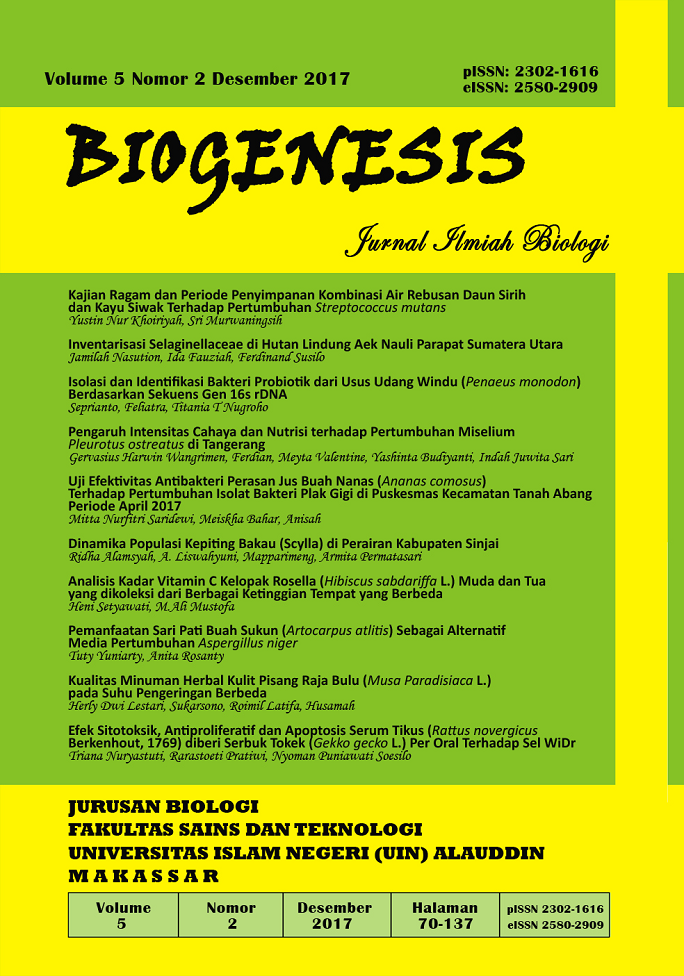Uji Efektivitas Antibakteri Perasan Jus Buah Nanas (Ananas comosus) Terhadap Pertumbuhan Isolat Bakteri Plak Gigi di Puskesmas Kecamatan Tanah Abang Periode April 2017
Abstract
Dental caries or commonly known as “Tooth Decay” is one of the most common infection on human. Dental caries begins by the formation of dental plaque and it is a multifactorial disorder. One of the efforts to prevent the formation of dental caries is by utilizing plants which contain antibacterial substance. Pineapple contains bromelain, saponin, flavonoid, and tannin enzymes which functions as antibacteria. This research aimed to discover the antibacterial effectiveness of pineapple juice toward the isolate growth of dental plaque bacteria by using three different pineapple juice concentrations (25%, 50%, and 75%). The method was experimental by using dental bacteria isolate from a patient of Dental and Oral Clinic in Puskesmas Kecamatan Tanah Abang. The result shows that the higher concentration shows the bigger inhibition zone diameter formed around the plate’s paper. Consequently in concentrations of 25%, 50%, and 75%, each has its own inhibition zone rate as much as 2,90 mm (weak); 3,89 mm (weak); and 5,89 mm (moderate).
References
Allaker RP and Douglas CWI. 2009. Novel Anti-Microbial Therapies for Dental Plaque-Related Diseases. International Journal of Antimicrobial Agents. vol 33(1): 8-13. DOI: https://doi.org/10.1016/j.ijantimicag.2008.07.014.
Angraeni DP dan Rahmawati AD. 2012. Efektivitas daya antibakteri ekstrak kulit nanas (Ananas comosus (L) Merr) terhadap pertumbuhan Streptococcus mutans. [Skripsi]. Yogyakarta: Pendidikan Dokter Gigi Universitas Muhammadiyah Yogyakarta.
Au TK, Lam TL, Ng TB, Fong WP, Wan DCC. 2001. A comparison of HIV-1 integrase inhibition by aqueous and methanol extracts of Chinese medicinal herbs. Life Sciences. vol 68(14): 1687-1694. DOI: https://doi.org/10.1016/S0024-3205(01)00945-6.
Cahyono B. 2011. Buku Terlengkap Budidaya Nanas secara Komersial. Jakarta: Pustaka Mina.
Cushnie TPT and Lamb AJ. 2005. Antimicrobial activity of flavonoids. International Journal of Antimicrobial Agents. vol 26(5): 343-356. DOI: https://doi.org/10.1016/j.ijantimicag.2005.09.002.
Dahlan MS. 2011. Statistik Untuk Kedokteran dan Kesehatan Edisi 5. Jakarta: Salemba Medika
Davis WW and Stout TR. 1971. Disc Plate Method of Microbiological Antibiotic Assay. Applied and Enviromental Microbiology. vol. 22 (4): 666-670.
Houwink, Dirks B, Winchel C. 2000. Ilmu Kedokteran Gigi Pencegahan. Yogyakarta: Gadjah Mada University Press.
Jo JY, de Mejia EG, Lila MA. 2005. Effects of Grape Cell Culture Extracts on Human Topoisomerase II Catalytic Activity and Characterization of Active Fractions. J. Agric. Food Chem, vol 53 (7): 2489–2498. DOI https://doi.org/10.1021/jf048524w.
Kidd EAM dan Bechal SJ. 2005. Dasar-dasar Karies: Penyakit dan Penanggulangannya. Jakarta: EGC.
Kongsuwan A, Suthiluk P, Theppakorn T, Srilaong V and Setha S. 2009. Bioactive compounds and antioxidant capacities of phulae and nanglae pineapple. As. J. Food Ag-Ind. vol 2, Special Issue: S44-S50.
Nurhidayah, Masriany, Masri M. 2013. Isolasi dan Pengukuran Aktivitas Enzim Bromelin dari Ekstrak Kasar Batang Nanas (Ananas comosus) Berdasarkan Variasi pH. Biogenesis. vol 1(2): 116-122. DOI: https://doi.org/10.24252/bio.v1i2.457.
Makalew MAJ, Nangoy E, Wowor PM. 2016. Uji Efek Antibakteri Air Perasan Daging Buah Nanas (Ananas comosus (L.) merr) Terhadap bakteri Klebsiella pneumonia. Jurnal e-Biomedik. vol 4(1): 1-6.
Parwata IMOA dan Dewi PFS. 2008. Isolasi dan Uji Aktivitas Antibakteri Minyak Atsiri Dari Rimpang Lengkuas (Alpinia galanga L.). Jurnal Kimia (Journal of Chemistry). vol 2(2): 100-104.
Pratiwi I. 2009. Uji Antibakteri Ekstrak Kasar Daun Acalypha indica Terhadap Bakteri Salmonella choleraesuis dan Salmonella typhimurium. [Skripsi]. Surakarta: Jurusan Biologi FMIPA Universitas Sebelas Maret.
Puskesmas Kecamatan Tanah Abang. 2016. Laporan Jumlah Pasien Pada Poli Gigi dan Mulut Tahun 2016. Jakarta Pusat.
Rakhmanda AP. 2008. Perbandingan Efek Antibakteri Jus Nanas (Ananas comosus L. merr) Pada Berbagai Konsentrasi Terhadap Streptococcus mutans. [KTI]. Semarang: Fakultas kedokteran, Universitas Diponegoro.
Riskesdas. 2007. Hasil Riset Kesehatan Dasar 2007. Jakarta: Badan Penelitian dan Pengembangan Kesehatan Kementerian Kesehatan RI. www.depkes.go.id. Diakses September 2017.
Riskesdas. 2013. Hasil Riset Kesehatan Dasar 2013. Jakarta: Badan Penelitian dan Pengembangan Kesehatan Kementerian Kesehatan RI. www.depkes.go.id. Diakses September 2017.
Wilson M. 2004. Lethal Photosensitisation of Oral Bacteria and Its Potential Application in the Photodynamic Therapy of Oral Infections. Photochem. Photobiol. Sci. vol 5(3): 412-418. DOI: https://doi.org/10.1039/B211266C.
World Health Organization. 2008. Oral Health Information Systems 2008. http://www.who.int. diakses Oktober 2017.
Copyright (c) 2018 Mitta Nurfitri Saridewi, Meiskha Bahar, Anisah Anisah

This work is licensed under a Creative Commons Attribution 4.0 International License.
COPYRIGHT AND LICENSE STATEMENT
COPYRIGHT
Biogenesis: Jurnal Ilmiah Biologi is published under the terms of the Creative Commons Attribution license. Authors hold the copyright and retain publishing rights without restriction to their work. Users may read, download, copy, distribute, and print the work in any medium, provided the original work is properly cited.
LICENSE TO PUBLISH
1. License
The use of the article will be governed by the Creative Commons Attribution license as currently displayed on http://creativecommons.org/licenses/by/4.0.
2. Author’s Warranties
The author warrants that the article is original, written by stated author/s, has not been published before, contains no unlawful statements, does not infringe the rights of others, is subject to copyright that is vested exclusively in the author and free of any third party rights, and that any necessary written permissions to quote from other sources have been obtained by the author(s).
3. User Rights
Under the Creative Commons Attribution license, the users are free to download, reuse, reprint, modify, distribute and/or copy the content for any purpose, even commercially, as long as the original authors and source are cited. No permission is required from the authors or the publishers.
4. Co-Authorship
If the article was prepared jointly with other authors, the corresponding author warrants that he/she has been authorized by all co-authors, and agrees to inform his/her co-authors of the terms of this statement.
5. Miscellaneous
Biogenesis: Jurnal Ilmiah Biologi may conform the article to a style of punctuation, spelling, capitalization, and usage that it deems appropriate. The author acknowledges that the article may be published so that it will be publicly accessible and such access will be free of charge for the readers.


